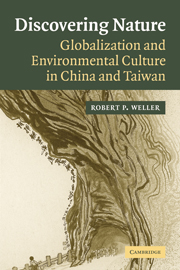Book contents
- Frontmatter
- Contents
- List of illustrations
- Acknowledgments
- 1 Discovering nature
- 2 Night of the living dead fish
- 3 New natures
- 4 Stories of stone
- 5 Garbage wars and spiritual environments
- 6 On “policies from above and countermeasures from below”
- 7 Globals and locals
- List of Chinese characters
- Bibliography
- Index
6 - On “policies from above and countermeasures from below”
Published online by Cambridge University Press: 05 June 2012
- Frontmatter
- Contents
- List of illustrations
- Acknowledgments
- 1 Discovering nature
- 2 Night of the living dead fish
- 3 New natures
- 4 Stories of stone
- 5 Garbage wars and spiritual environments
- 6 On “policies from above and countermeasures from below”
- 7 Globals and locals
- List of Chinese characters
- Bibliography
- Index
Summary
Both the Chinese and the Taiwanese governments have transformed their environmental policies since the 1980s, in part because their ways of thinking about nature have changed. China has replaced military images of the human conquest of nature, so popular during the Cultural Revolution and before, with closures of polluting factories, bans on leaded gas, and sales of organic food. China was the first country to produce a United Nations Agenda 21 document (outlining plans for sustainable development) under the Rio agreements of 1992. It has established an elaborate system of environmental regulations and the agencies to support them. It has staged periodic environmental campaigns, for instance promoting reforestation after the Yangzi River floods of 1998, or opposing pollution of the Huai River by paper factories. As I discussed in the previous chapter, it has also allowed foreign and indigenous environmental NGOs to play an active (if carefully delimited) role. Taiwan's actions have been roughly similar, although they are less tied to United Nations agreements because of the island's diplomatic limbo. Generally a few years in advance of China, Taiwan has also greatly increased the power and influence of its Environmental Protection Agency, passed or strengthened laws to protect endangered species and improve the quality of air and water, and cut back on extractive industries like forestry and mining.
Striking as these changes are, examining actual implementation of these policies exposes a much more complex and ambiguous situation.
- Type
- Chapter
- Information
- Discovering NatureGlobalization and Environmental Culture in China and Taiwan, pp. 137 - 160Publisher: Cambridge University PressPrint publication year: 2006

